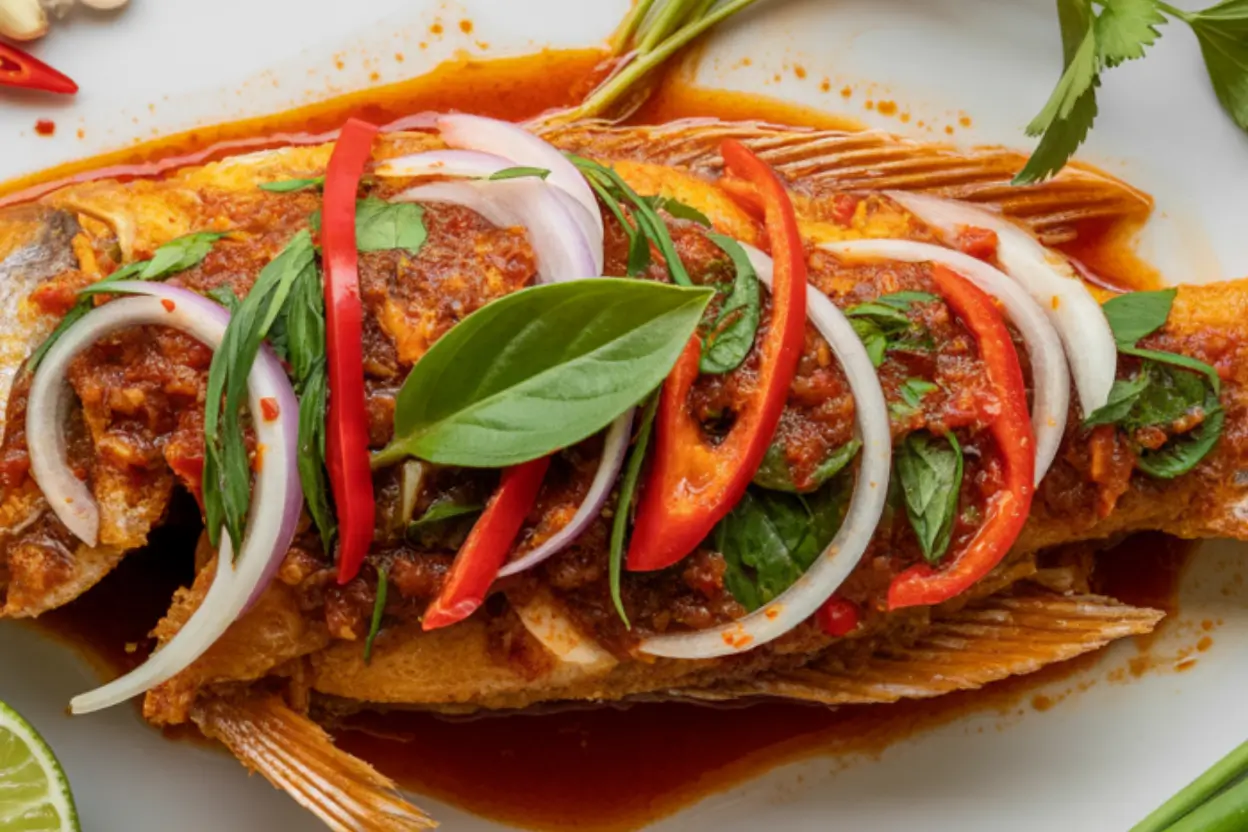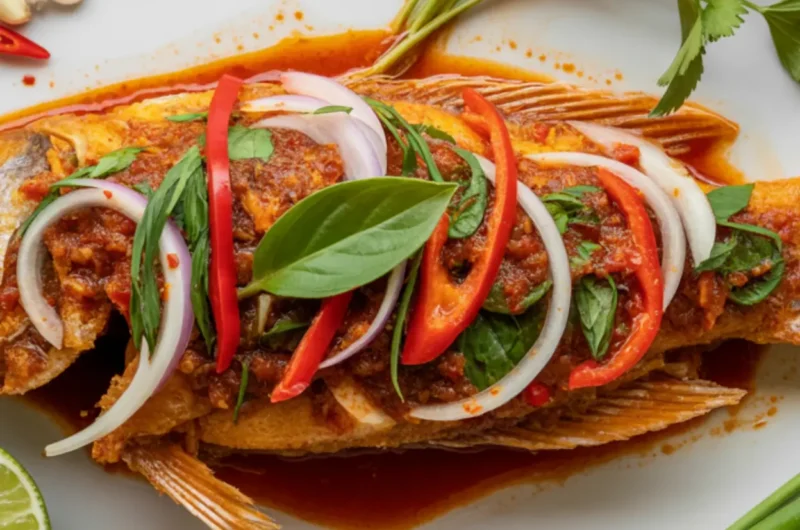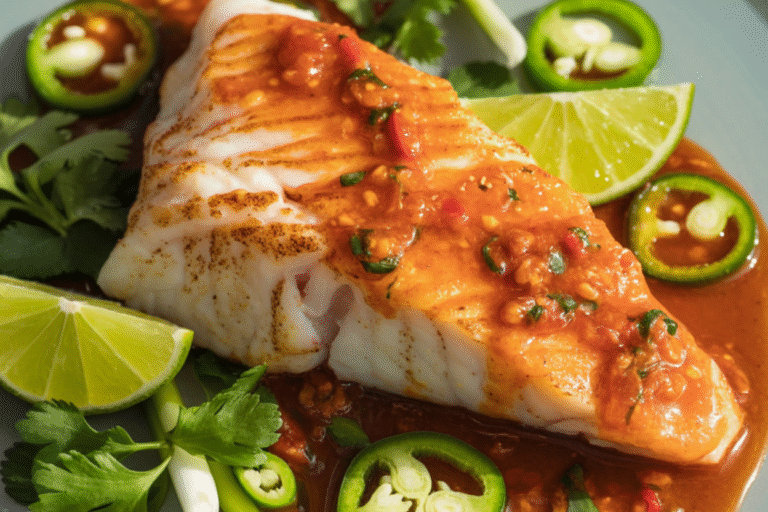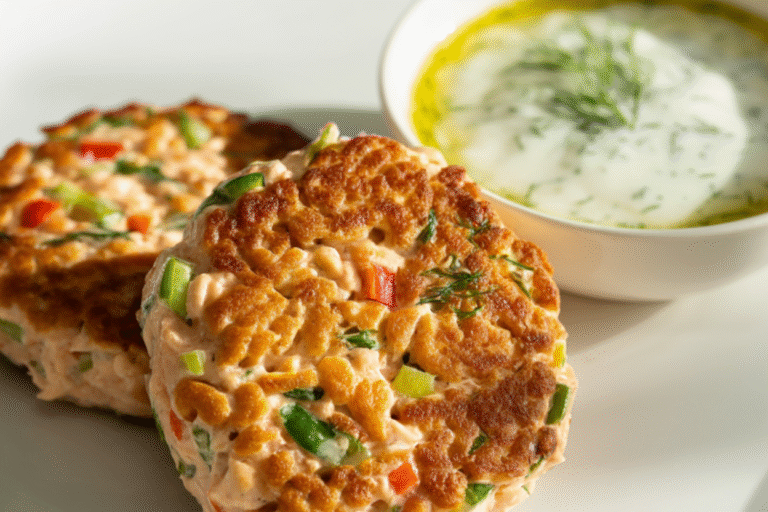Thai Spicy Catfish: How to Cook It Perfectly Every Time
Table of Contents
There’s something truly magical about Thai cuisine – the way it balances sweet, sour, salty, and spicy flavors creates dishes that are nothing short of extraordinary. Today, I’m sharing my recipe for Thai Spicy Catfish, a dish that exemplifies everything I love about Thai cooking. After years of perfecting this recipe, I’m confident you’ll achieve restaurant-quality results right in your own kitchen.
Thank you for reading this post, don't forget to subscribe!If you’ve been hesitant about cooking catfish at home or are looking to expand your Thai cooking repertoire, this recipe is the perfect place to start. The combination of aromatic herbs, fiery chilies, and tender catfish creates a dish that’s both impressive and approachable for home cooks of any skill level.
How to Make Thai Spicy Catfish
Quick Overview
Thai Spicy Catfish brings together the firm, mild flesh of catfish with an explosion of Thai flavors. What makes this dish special is the perfect balance of heat from Thai chilies, aromatic herbs like Thai basil and cilantro, and the perfect sauce that’s both tangy and savory. The catfish is first lightly fried until crispy on the outside while remaining moist and tender inside, then quickly stir-fried with the vibrant sauce and aromatics, allowing it to soak up all those incredible flavors.
One of the best things about this dish is how fast and easy it is to make. With just 15 minutes of preparation and about 20 minutes of cooking time, you can have an impressive, flavor-packed meal on the table in under 40 minutes. The quick cooking process also ensures that the fish stays tender while developing a wonderful crispy exterior that soaks up the sauce beautifully.
The combination of the perfectly cooked catfish with the aromatic, spicy sauce creates a dish that hits all the right notes – crispy, tender, spicy, aromatic, and savory. Whether you’re cooking for family or impressing dinner guests, this Thai Spicy Catfish delivers maximum flavor with minimal effort.
The Ingredients I Use to Bring My Thai Spicy Catfish to Life
For the catfish:
- 1.5 pounds (about 700g) catfish fillets, cut into 2-inch pieces
- 1 tablespoon lime juice
- ½ teaspoon salt
- ¼ teaspoon white pepper
- ¼ cup cornstarch
- ⅓ cup vegetable oil for frying
For the sauce:
- 3 tablespoons fish sauce
- 2 tablespoons lime juice
- 1 tablespoon palm sugar or brown sugar
- 1 tablespoon soy sauce
- 1 teaspoon tamarind paste (optional, but adds authentic tanginess)
- 2 tablespoons water
For the aromatics:
- 6 cloves garlic, minced
- 4-8 Thai bird’s eye chilies, sliced (adjust according to your heat preference)
- 2 red bell peppers, sliced into thin strips
- 1 medium onion, sliced
- 3 stalks lemongrass, tender inner parts only, finely minced
- 2-inch piece of galangal or ginger, julienned
- 3 kaffir lime leaves, thinly sliced (optional, but recommended for authentic flavor)
- 1 cup Thai basil leaves
- ¼ cup fresh cilantro leaves, roughly chopped
For garnish:
- Extra Thai basil leaves
- Lime wedges
- Thinly sliced red chilies
- 2 green onions, sliced diagonally
Step-by-Step Instructions
Step 1: Prepare the Catfish
- Rinse the catfish fillets under cold water, then thoroughly dry them with paper towels. Getting them completely dry is key to a nice, crispy crust when frying.
- Place the catfish pieces in a medium bowl and sprinkle with lime juice, salt, and white pepper. Gently toss to ensure all pieces are evenly coated.
- Let the catfish marinate for 10 minutes at room temperature. This brief marination helps remove any potential muddy flavor and begins to season the fish.
- While the fish is marinating, prepare your sauce by combining fish sauce, lime juice, palm sugar, soy sauce, tamarind paste (if using), and water in a small bowl. Stir until the sugar is completely dissolved. Set aside.
- After marinating, drain any excess liquid from the catfish pieces.
- Place cornstarch in a shallow dish and lightly coat each piece of catfish, shaking off any excess. You want just a thin layer to create a light crispiness.
Step 2: Fry the Catfish
- Heat vegetable oil in a large wok or heavy-bottomed skillet over medium-high heat until it shimmers (about 350°F/175°C if you have a thermometer).
- Working in batches to avoid overcrowding, carefully add the coated catfish pieces to the hot oil. Overcrowding will lower the oil temperature and result in soggy rather than crispy fish.
- Fry for 3-4 minutes on each side until the exterior is golden and crispy, and the fish is just cooked through. Catfish cooks quickly, so be careful not to overcook it.
- Using a slotted spoon, transfer the fried catfish to a paper towel-lined plate to drain excess oil.
- Pour off all but 2 tablespoons of oil from the wok or skillet, keeping the flavorful residue from frying the fish.
Step 3: Create the Aromatic Base
- Return the wok to medium-high heat. Add the minced garlic and sliced chilies, and stir-fry for 30 seconds until fragrant but not browned. Garlic burns easily, so watch it carefully.
- Add the sliced red bell peppers and onion, and continue to stir-fry for another 2 minutes until they begin to soften but still retain some crunch.
- Add the minced lemongrass, julienned galangal or ginger, and sliced kaffir lime leaves (if using). Stir-fry for another minute to release their aromas.
Step 4: Bring Everything Together
- Pour the prepared sauce into the wok and bring to a rapid simmer for about 30 seconds.
- Carefully slide the fried catfish pieces back into the wok, gently tossing to coat with the sauce. Be gentle to avoid breaking up the fish.
- Allow everything to simmer together for just 1-2 minutes, until the sauce slightly thickens and coats the fish. The goal is to infuse the fish with flavor without overcooking it.
- Turn off the heat and add the Thai basil and cilantro, folding them gently into the dish just until wilted from the residual heat.
Step 5: Serve
- Immediately transfer the Thai Spicy Catfish to a serving platter, making sure to include all the sauce and aromatics.
- Garnish with extra Thai basil leaves, lime wedges, sliced red chilies, and green onions.
- Serve it hot with a side of steamed jasmine rice to soak up all that flavorful sauce.
What to Serve Thai Spicy Catfish With
Thai Spicy Catfish is a bold, flavorful main dish that pairs beautifully with several complementary sides. Here are some excellent pairing options:
Traditional Thai accompaniments:
- Steamed jasmine rice – the perfect canvas for soaking up the flavorful sauce
- Coconut rice – adds a subtle sweetness that balances the spice
- Som tam (green papaya salad) – provides a refreshing crunch and tangy contrast
- Cucumber relish – the cool crispness helps balance the heat of the dish
Vegetable sides:
- Stir-fried morning glory (water spinach) with garlic
- Steamed or stir-fried bok choy
- Simple stir-fried vegetables like broccoli, carrots, and snap peas
- Thai-style omelet with herbs (kai jeow)
Soup options:
- Tom kha (coconut soup) – its creamy richness complements the spicy fish
- Simple clear broth with vegetables
Beverage pairings:
- Thai iced tea
- Coconut water
- Cucumber-mint infused water
- Lemongrass iced tea
For a complete Thai meal experience, serve this dish family-style alongside 2-3 complementary dishes of varying flavors and textures.

Top Tips for Perfecting Thai Spicy Catfish
Fish selection and preparation:
- Look for fresh catfish with firm flesh and no strong fishy odor
- If you can’t find catfish, tilapia, snapper, or cod can be good substitutes
- Always pat the fish completely dry before coating and frying
- For extra crispiness, you can score the skin side of the fillets with shallow cuts
Heat management:
- Keep your oil at a consistent temperature (around 350°F/175°C) for even frying
- If the oil starts smoking, it’s too hot and will give the fish a burnt taste
- If the oil isn’t hot enough, the fish will absorb too much oil and become greasy
- Use a splatter screen to prevent messy oil splatters when frying
Ingredient substitutions and adjustments:
- No Thai bird’s eye chilies? Substitute with serrano or small red chilies
- Can’t find fresh galangal? Ginger makes a good substitute, though the flavor will be different
- No kaffir lime leaves? Use lime zest for a similar citrusy aroma
- Thai basil is important for authentic flavor, but in a pinch, you can use Italian basil
- For a milder version, reduce the number of chilies and remove the seeds
- If you find the sauce too salty, balance it with a little more lime juice or sugar
Common mistakes to avoid:
- Don’t overcrowd the pan when frying the fish – work in batches for best results
- Avoid overcooking the catfish – it should be just cooked through to remain tender
- Don’t add the herbs too early – they should be added at the very end to maintain their fresh flavor and color
- Resist the urge to stir the fish too much in the sauce – gentle folding prevents the fish from breaking apart
For extra fragrance:
- Dry-toast your dried spices before using them to enhance their aroma
- Bruise lemongrass stalks before mincing to release more flavor
- Consider adding a tablespoon of finely chopped makrut lime leaves for an authentic Thai fragrance
Storing and Reheating Tips
While Thai Spicy Catfish is best enjoyed immediately after cooking when the fish is at its most crispy and the herbs are freshest, there are ways to store and reheat leftovers effectively:
Short-term storage:
- Allow leftovers to cool completely before refrigerating (but don’t leave at room temperature for more than 2 hours)
- Store in an airtight container in the refrigerator for up to 2 days
- Store the sauce separately from any unused fried fish if possible, to preserve crispiness
Freezing (not ideal but possible):
- This dish is not ideal for freezing, as the texture of the fish and vegetables will change significantly
- If you must freeze, store in airtight containers for up to 1 month
- Expect the fish to lose its crispy texture when thawed
Best reheating methods:
- Oven method (preferred for maintaining some crispiness): Preheat oven to 350°F (175°C), place fish and sauce in an oven-safe dish, cover with foil, and heat for 10-15 minutes until warmed through.
- Stovetop method: Gently reheat in a non-stick pan over medium-low heat, adding a splash of water to the sauce if it has thickened too much.
- Microwave (quickest but least optimal for texture): Use 70% power in 30-second increments, stirring between intervals.
- Toss in some fresh herbs after reheating to bring the flavors back to life.
Repurposing leftovers:
- Transform leftover Thai Spicy Catfish into a flavorful rice bowl by serving it over fresh rice with additional vegetables
- Use flaked leftover catfish to create Thai-inspired fish cakes
- Add to a coconut-based soup for a Thai fusion fish soup
- Wrap in lettuce leaves with fresh herbs and cucumber for a light lunch option
Freshness indicators:
- Trust your senses – if the fish smells strongly fishy or sour, discard it
- If the sauce has separated significantly or changed color drastically, it’s best not to risk consuming it
Thai Spicy Catfish represents the perfect balance of flavors and textures that make Thai cuisine so beloved worldwide. The combination of crispy-fried catfish with the aromatic, spicy sauce creates a dish that’s both comforting and exciting. By following these detailed steps and tips, you’ll be able to create an authentic Thai experience in your own kitchen, impressing family and friends with your culinary prowess.
Remember, the key to exceptional Thai cooking lies in balance – finding that perfect harmony between sweet, sour, salty, and spicy elements that makes each bite a new discovery. Don’t be afraid to adjust the spice level or ingredients to suit your taste preferences while maintaining the essence of this magnificent dish.
Thai Spicy Catfish: How to Cook It Perfectly Every Time
Cuisine: ThaiDifficulty: Medium4
servings20
minutes15
minutes400–450
kcalThis Thai Spicy Catfish recipe delivers bold, aromatic heat with layers of flavor from chilies, lemongrass, lime, and fresh herbs. Crispy catfish pieces are coated in a zesty, spicy sauce that’s perfect over jasmine rice for a fiery and satisfying meal.
Ingredients
1.5 pounds (about 700g) catfish fillets, cut into 2-inch pieces
1 tablespoon lime juice
½ teaspoon salt
¼ teaspoon white pepper
¼ cup cornstarch
⅓ cup vegetable oil for frying
3 tablespoons fish sauce
2 tablespoons lime juice
1 tablespoon palm sugar or brown sugar
1 tablespoon soy sauce
1 teaspoon tamarind paste (optional, but adds authentic tanginess)
2 tablespoons water
6 cloves garlic, minced
4-8 Thai bird’s eye chilies, sliced (adjust according to your heat preference)
2 red bell peppers, sliced into thin strips
1 medium onion, sliced
3 stalks lemongrass, tender inner parts only, finely minced
2-inch piece of galangal or ginger, julienned
3 kaffir lime leaves, thinly sliced (optional, but recommended for authentic flavor)
1 cup Thai basil leaves
¼ cup fresh cilantro leaves, roughly chopped
Extra Thai basil leaves
Lime wedges
Thinly sliced red chilies
2 green onions, sliced diagonally
Directions
- Prep the Catfish and Sauce
Start by rinsing and thoroughly drying the catfish pieces—this step ensures a crispy finish when frying. Toss the fish with lime juice, salt, and white pepper, and let it marinate for 10 minutes at room temperature. Meanwhile, whisk together the sauce ingredients—fish sauce, lime juice, palm sugar, soy sauce, tamarind paste (if using), and water—until the sugar dissolves. After marinating, lightly coat each piece of catfish in cornstarch, shaking off the excess. - Fry the Catfish
Heat oil in a wok or skillet over medium-high heat until shimmering. Fry the catfish pieces in batches for 3–4 minutes per side, until golden and crispy. Don’t overcrowd the pan. Transfer the fried fish to a paper towel-lined plate, then carefully pour off most of the oil, leaving about 2 tablespoons and the flavorful bits behind. - Sauté the Aromatics
In the same pan, add garlic and Thai chilies, and stir-fry for 30 seconds until fragrant. Then toss in red bell peppers and onions, cooking them until just tender but still slightly crisp. Add lemongrass, galangal or ginger, and kaffir lime leaves, and cook for another minute to release their rich aromas. - Combine and Simmer
Pour the sauce into the wok and bring it to a quick simmer. Gently return the fried catfish to the pan and toss to coat evenly with the sauce. Let everything cook together for 1–2 minutes, just until the sauce thickens slightly. Turn off the heat and stir in Thai basil and cilantro until just wilted. - Garnish and Serve
Transfer the catfish to a serving platter, making sure to spoon over all the sauce and aromatics. Garnish with extra Thai basil, lime wedges, sliced red chilies, and green onions. Serve hot with steamed jasmine rice to soak up every bit of the flavorful sauce.
Notes
- This dish is all about balance—spicy, salty, sour, and slightly sweet. The use of fresh lemongrass, kaffir lime leaves, and Thai basil gives it that signature Thai aroma and depth. If you can’t find catfish, you can substitute with any firm white fish. And while tamarind paste is optional, it adds a wonderful tang that enhances the sauce beautifully. Adjust the heat to your preference using more or fewer Thai chilies.








